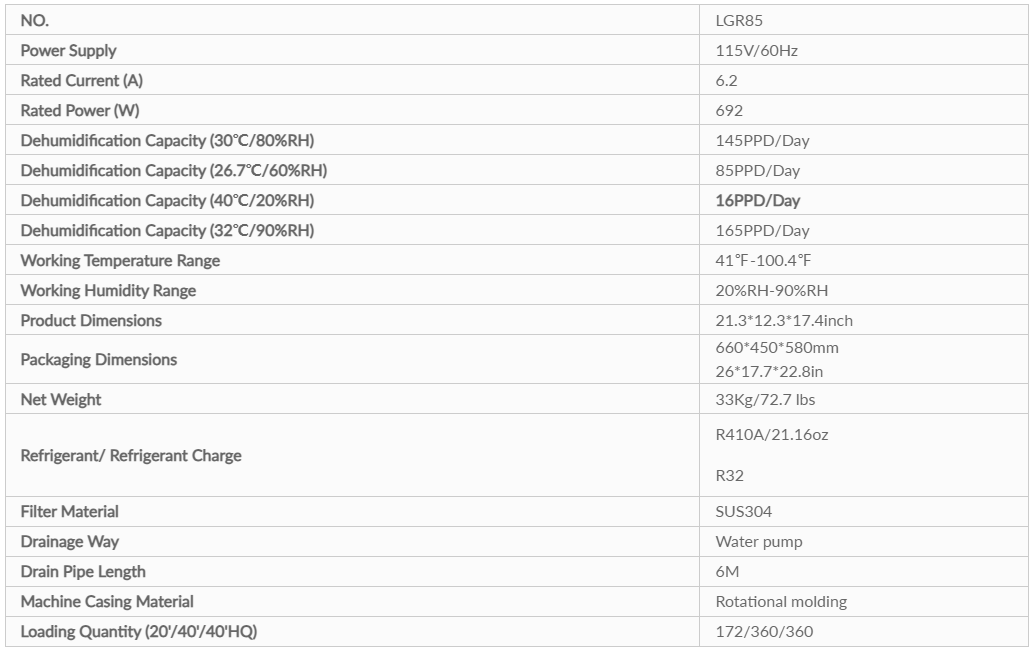Choosing an industrial strength dehumidifier requires careful consideration of several factors to ensure it meets your specific needs and requirements.
Essential steps to guide you in selecting an industrial-strength dehumidifier
1. Identify your dehumidification needs:
Determine the size of the space you need to dehumidify and the desired humidity level. Calculate the area's cubic footage or square footage to get an idea of the dehumidifier's capacity requirements.
2. Consider the extraction rate:
Look for dehumidifiers with high extraction rates, usually measured in pints or liters per day (PPD or LPD). Industrial dehumidifiers typically have higher extraction rates than residential models.
3. Check humidity control options:
Ensure that the dehumidifier has accurate and reliable humidity control settings. Some industrial units come with built-in hygrostats to maintain a specific humidity level automatically.
4. Evaluate the operating temperature range:
Check the dehumidifier's operating temperature range to ensure it can handle the conditions in your industrial environment. Some models may not function optimally in extreme temperatures.
5. Assess the drainage system:
Industrial dehumidifiers often produce a significant amount of condensate. Look for units that have efficient drainage options, such as gravity drainage, pump drainage, or hose connection for continuous draining.
6. Consider portability and mobility:
Depending on the industrial setting, you may need a dehumidifier that can be easily moved around the facility. Look for units with sturdy wheels or handles for easy transportation.
7. Look for durable construction:
Industrial environments can be harsh, so choose a smart dehumidifier made of robust materials that can withstand potential bumps, knocks, or rough handling.
8. Energy efficiency:
Consider the dehumidifier's energy efficiency, as industrial units can consume a significant amount of power. Look for models with an Energy Star certification or other energy-efficient features.
9. Noise level:
Check the noise level of the dehumidifier, primarily if it will be used in an occupied workspace. Some industrial models can be noisy, so find a balance between performance and noise output.
10. Warranty and service:
Ensure the dehumidifier comes with a reasonable warranty and has reliable customer service and technical support in case any issues arise.
11. Compare brands and models:
Research different brands and models to find the best industrial dehumidifier that meets your specific requirements and budget.
By following these steps, you can select an industrial strength dehumidifier that is well-suited for your facility's requirements, helping to maintain a comfortable and controlled environment.
Specifications of Preair LGR85 dehumidifier for water damage
If you want to select a proper dehumidifier, you can follow the above steps to study the data of a dehumidifier.

For example, the operation range of the LGR85 dehumidifier is 41℉-100.4℉ / 20%RH-90%RH. The dehumidification capacity of the LGR85 dehumidifier is 85PPD/Day (@26.7℃/60%RH). It adopts a water pump and equips a 6m pipe to drain. Preair LGR dehumidifiers are usually applied in water damage restoration, and the dehumidification of construction sites, basements, wine cellars, garages, shopping malls, and other commercial & industrial scenarios.
Post time: Aug-02-2023
 +86-13376814803
+86-13376814803  robert@hzhongtai.com
robert@hzhongtai.com 












